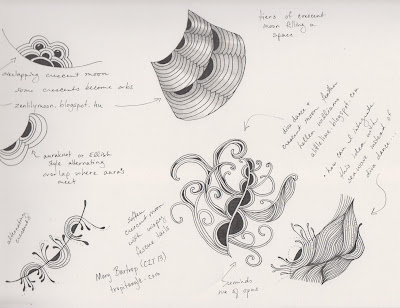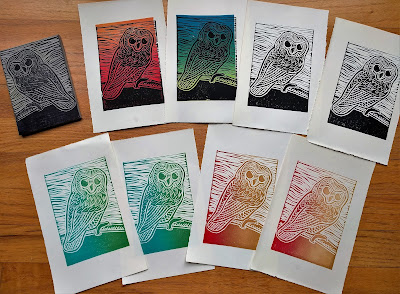Pattern. If you know only one thing about Zentangle, you know that it's all about pattern!
Diva Challenge #293: Keeko
Some of the simplest visual elements you can repeat to create pattern are dots, lines, curves and circles. Keeko taps into this fundamental aspect of pattern design with an elegant simplicity. This simple building block can be a source of meditative repetition or inspire a curious "what if...?"
It's A String Thing #171
For some reason, I have never really embraced the Zentangle pattern Crescent Moon, another fundamentally basic pattern. I didn't find it very pleasing to draw and frankly I've avoided it. When this week's String Adventure called for Seawave (which I feel in love with instantly) combined with Crescent Moon (my nemesis!), I knew I had to find some inspiration.
On Pinterest I found a be-fescue'd version that I find absolutely delightful. I have to give credit to Mary Bartrop (CZT13) for making me a Crescent Moon convert! Shout-out to Lily Moon and Helen Williams for their inspiring versions as well. I've pinned a few to my Patterns and Tangles board if you want to check them out. Once I've found some inspiration, here's one way that I use my sketch book to record inspiration and to help me generate ideas.
And here's the tile I created after finding a way to love Crescent Moon after all and marry it with that deliciously textured and organic pattern Seawave.
The Zentangle Method naturally incorporates many of the classic principles of design while still allowing for a relaxed and improvisational experience. I like to use my sketchbook to try out new ideas and consider questions of contrast, balance, and rhythm in the context of these patterns we call Tangles. Then when I sit down with my pen and a tile, I take a deep breath and allow those explorations to blossom into a complete thought.
What about you? Which principles of design come naturally to you when you tangle?
Pinterest: Principles of Design poster
pat·ternˈpadərn/noun1. a repeated decorative design.
2. the repetition of specific visual elements such as a unit of shape or form.
Diva Challenge #293: Keeko
Some of the simplest visual elements you can repeat to create pattern are dots, lines, curves and circles. Keeko taps into this fundamental aspect of pattern design with an elegant simplicity. This simple building block can be a source of meditative repetition or inspire a curious "what if...?"
 |
| Keeko, Arc Flower for Diva #293 |
 |
| Keeko in 3D on a warped grid for Diva #293 |
It's A String Thing #171
For some reason, I have never really embraced the Zentangle pattern Crescent Moon, another fundamentally basic pattern. I didn't find it very pleasing to draw and frankly I've avoided it. When this week's String Adventure called for Seawave (which I feel in love with instantly) combined with Crescent Moon (my nemesis!), I knew I had to find some inspiration.
On Pinterest I found a be-fescue'd version that I find absolutely delightful. I have to give credit to Mary Bartrop (CZT13) for making me a Crescent Moon convert! Shout-out to Lily Moon and Helen Williams for their inspiring versions as well. I've pinned a few to my Patterns and Tangles board if you want to check them out. Once I've found some inspiration, here's one way that I use my sketch book to record inspiration and to help me generate ideas.
 |
| use your sketchbook to generate ideas |
And here's the tile I created after finding a way to love Crescent Moon after all and marry it with that deliciously textured and organic pattern Seawave.
Crescent Moon, Seawave
for IAST #171
The Zentangle Method naturally incorporates many of the classic principles of design while still allowing for a relaxed and improvisational experience. I like to use my sketchbook to try out new ideas and consider questions of contrast, balance, and rhythm in the context of these patterns we call Tangles. Then when I sit down with my pen and a tile, I take a deep breath and allow those explorations to blossom into a complete thought.
What about you? Which principles of design come naturally to you when you tangle?










